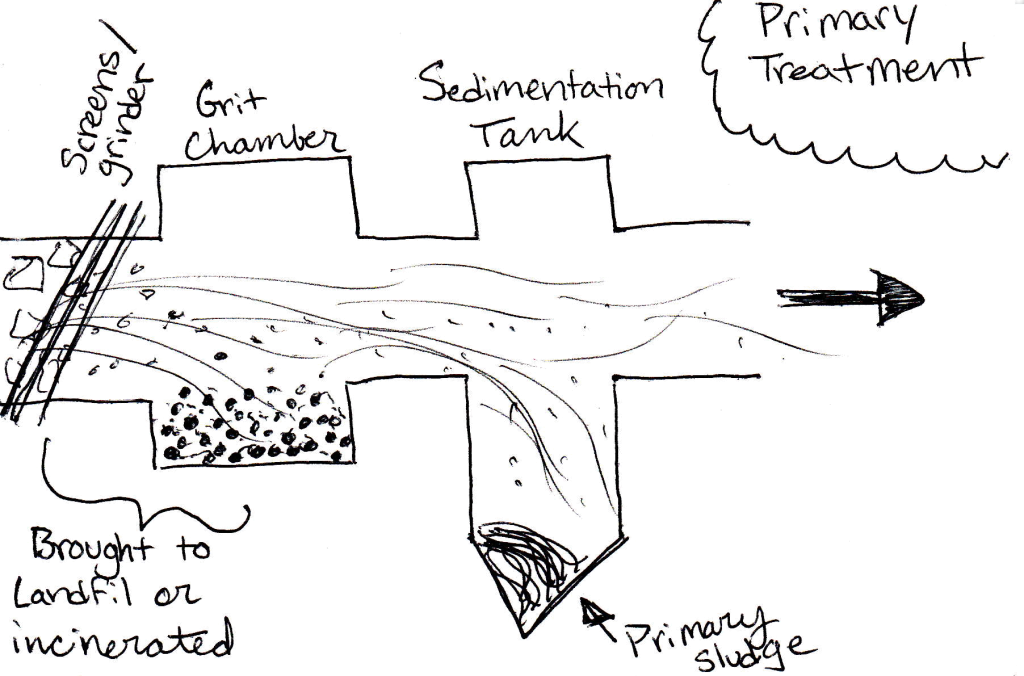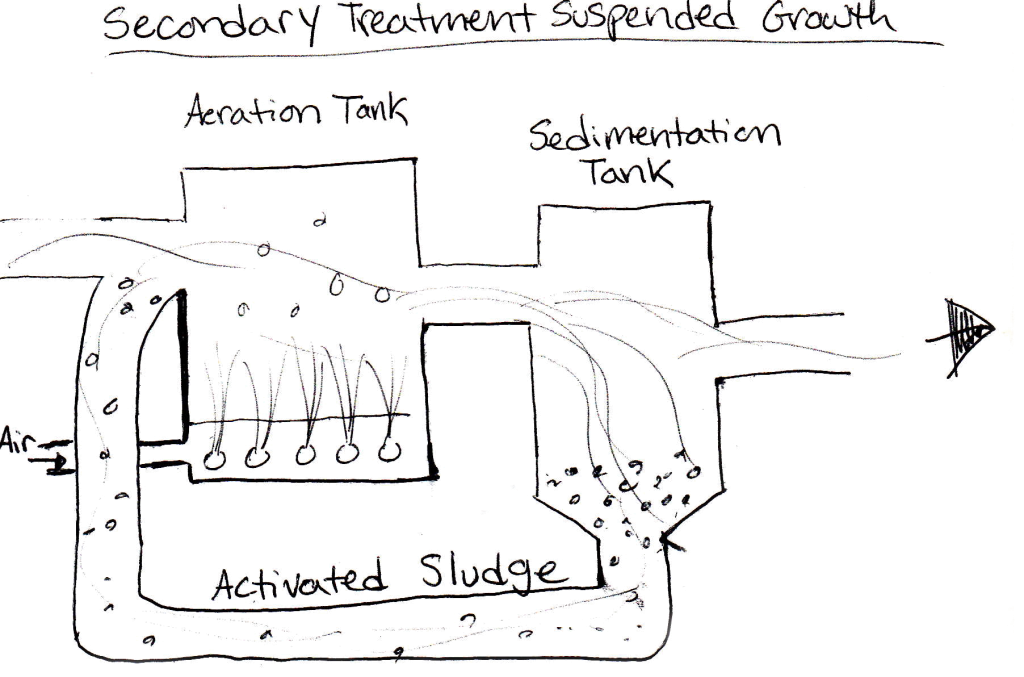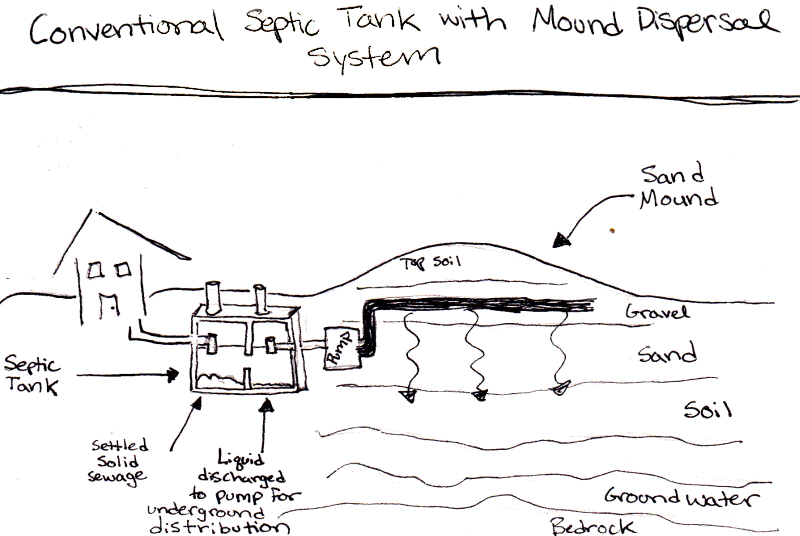Our Waste Goes Where?!
Dear Readers,
Our bodies need nutrients to survive. As we consume, we produce waste. This waste is processed. Occasionally, the processed poop ends up as fertilizer and provides nutrients to our nutrients. We then consume said fertilized nutrients…and set them free again! ‘Tis more than the Cycle of Poop. In truth (a deeper more philosophical existential sense…), it is the cycle of life~ where every living being, plant to animal, has a purpose…and even its demise results in a form of rebirth and a giving of life to another. Poop has a Purpose.
In a much more scientific and detailed manner, I am now going to explain to you, dear readers, the step by step processes for how city people take care of their waste (Centralized Wastewater Collection and Treatment) and how country folk take care of their waste (Decentralized Wastewater Collection and Treatment). I will attempt to keep it concise and organized (and all existential crises excluded)…as cleaning poop can be a messy endeavor.
Centralized Wastewater Collection and Treatment (the city way to treat waste…)
Before the rapid boom in population and industry, water had this incredible ability to make itself clean to drink. Up to the 1972 Clean Water Act, we as a population here in the United States relied upon water’s super power of self-purification and dumped our human and other waste straight into rivers, lakes, and oceans.
Well, now there are too many of us… and our existence and usage of altered substances has become water’s kryptonite. Water can’t clean itself anymore on its own. To help water speed up its natural processes of purification, our society has created ‘centralized’ wastewater treatment facilities. All of the waste from homes, businesses, industries, and other facilities in a city go to this wastewater plant.1
Before delving into the step by step processes of cleaning waste, the three main methods used to treat wastewater should be briefly explained:
Physical: fishing and filtering for poo
-Pass wastewater through screens to remove debris and solids.
-Solids that are heavier than water will settle out from wastewater by gravity and can then be removed.
-Solids with entrapped air will float to the top of water and can be removed.
Biological: nom nom nom…
Bacteria and other small, hungry organisms in water consume organic matter (poop) in sewage. However, the bacteria are much more productive in devouring waste when they have the help of oxygen. The wastewater treatment plant therefore adds oxygen to wastewater, and the bacteria is noted to increase and rapidly eat organic pollutants. You can think of oxygen as hardcore ‘caffeine’ for these microorganisms: boosts their metabolism and energy, so that they desperately consume everything in sight, and are much more efficient in what they are required to do.
Chemical: Abracadabra! Now I can catch you easier my pretty (poop)!
-Chemicals can be added to clump pollutants together, making them easier to remove.
-Example: alum, lime, or iron salts once added to wastewater can cause certain pollutants to bunch together into large, heavier masses.
-Polymers are also sometimes used.2
~see personal note in references, if you feel like it, number 3.3
Pre-Step One: Pretreatment
Are you ready for a bit of irony? Just as excess human and industry waste are water’s kryptonite in the self-purification process…excess pollutants from industries are treatment plants’ kryptonite in the wastewater treatment process. A large amount of pollutants (especially ones when combined can cause toxic fumes), create hazards and “interfere with the operation and performance” of the wastewater treatment facility. Industries are therefore required to develop their own waste management system and control the amount of pollutants discharged into the municipal sewer systems.4 Generic and specific prohibited pollutants can be found on the EPA’s website, here.5 It makes you wonder if our energies would be better served by reducing the use of pollutants in the first place, doesn’t it?
Anywho, back to the poo…
Step One, for real: Primary Treatment
Primary treatment is broken down into two stages, Preliminary Treatment and Primary Sedimentation.
Preliminary Treatment: screens remove large floating objects, “such as rags, cans, bottles and sticks” that may cause clogging down the pipeline. Some wastewater treatment facilities get fancy and use screens which also act as a grinder! The grinder/screen chops up the solid waste and then lets the remnants flow to a ‘grit chamber.’ In the grit chamber, all of the, well, grit, sinks to the bottom. The settled grit and items caught by the initial screen must be removed and either brought to a landfill, or incinerated.6
Primary Sedimentation: Waste that does not settle in the grit chamber is carried by water to the sedimentation tank. The wastewater enters the sedimentation tank and slows down. The suspended solids gradually sink to the bottom. As the sunken solids accumulate, they become a large mass called primary sludge.7 Water, carrying rebel sedimentation that refuses to succumb to peer pressure and sink with its friends to the primary sludge gathering, continues to flow to secondary treatment, where it will undergo brutal remediation…
Rough Sketch of Primary Treatment in Centralized Wastewater Collection & Treatment Processes
Step Two: Secondary Treatment
Secondary treatment uses biological processes to remove up to 90% of remaining organic matter in wastewater. In other words, a majority of the rebel poop are about to be eaten by hungry microorganisms.
There are three different methods for secondary treatment, or, ‘brutal remediation’: Attached Growth Processes, Suspended Growth Processes, and Lagoons.
Attached Growth Processes: In this process, wastewater is passed over a stone or plastic ‘media.’ A media is a large surface area of whatever material the treatment plant chooses to use, corrugated plastic being a popular option. Upon the surface of this ‘media,’ with the help from an influx of additional oxygen (like a big cup o’ coffee…), a bunch of microbial growth occurs. These hungry little microorganisms then proceed to eat a majority of the rebel organic pollutants (poop).8 Because, if the rebels will not settle to be disposable primary sludge, they shall become a feast for oxygen-hyped microorganisms! Mwahahaha…
Oh, this process also results in more sludge, and settles out in a secondary treatment tank…So. Much. Sludge.
Suspended Growth Process: In this process, instead of the ravenous little microorganisms growing on a surface, they are grown (again, with the help of added oxygen) suspended in the water of an Aeration Tank. As the microorganisms grow in rank and break down the rebellion of organic matter, they create a giant biomass (like a mass feeding site…actually, kind of scary when you think of it that way…like zombies..), also known as ‘activated sludge.’ This activated sludge is carried with water to a sedimentation tank, where the sludge settles on the bottom. From this point, the activated sludge has the option of pursuing two different life cycles:
One, be recycled and sent back into the aeration tank to aid in the brutal consumption of rebel poop.
Two, be collected and used as ‘biosolids’….also known as ‘waste biomass,’ ‘sewage sludge,’ and ‘fertilizer.’9 Poop’s purpose…
Lagoons: A lagoon in this context is a man-made pond “that allows sunlight, algae, bacteria, and oxygen to interact.”10 Here microorganisms grow of their own accord, and the breakdown of organic matter becomes more of a slow remedial process…
Rough Sketch of Secondary Treatment, Suspended Growth in Centralized Wastewater Collection & Treatment Processes
Step Three: Advanced Treatment (optional…)
Sometimes, secondary treatment does not cut it. The wastewater is still not suitable to be dispersed over/through farmland or into wetlands. Gosh darn rebel poop…
There are four different means to pursue advanced treatment: nitrogen control, biological phosphorus control, coagulation-sedimentation, and carbon adsorption. Lots o’ big words…in an attempt to simplify…
They essentially need to remove the nitrogen, phosphorus, and remaining organic substances from the wastewater. A few of the ways they do this is through adding chemicals into the wastewater, using carbon granules, nitrification and sometimes denitrification.11
Step Four: The wastewater is disposed of through a variety of means
Having undergone secondary treatment, and maybe even advanced treatment, the wastewater continues onto its next stage of life…being disposed of in/on land, in a constructed wetland, or undergoing disinfection.
Land Treatment: In the land treatment process, the wastewater is disposed upon, yes, land. Often, it is used to irrigate crops. This is achieved through either slow rate infiltration, rapid infiltration, or overland flow.
-Slow Rate Infiltration: Wastewater is applied to the land, where the remaining rebel contaminants are filtered through the soil and eaten by hungry microorganisms or absorbed by plants. The water evaporates, is used by plants, is collected by drains or wells for surface discharge, or allowed to percolate into the groundwater.
-Rapid Infiltration: Same thing as ‘slow rate infiltration’…except with a much larger quantity of wastewater being dispersed over a much smaller amount of land. The water then primarily goes through the soil to meet the groundwater.
-Overland Flow: Wastewater travels down a slightly sloped area covered in deliberately planted vegetation (not the kind we eat in this case…). As the wastewater flows down the slope, the soil with the help of those microorganisms create a slimy layer which removes unwanted contaminants.12
Constructed Wetland: This one is easy to imagine. Picture a wetland, filled with vegetation such as reeds and wonderfully odiferous skunk weeds, except it was deliberately constructed to allow scientifically enhanced natural processes to filter out the waste.13
Disinfection: They disinfect wastewater by using chlorine (what they put in swimming pools), ozone (when oxygen is electrified), and ultraviolet radiation (this one is crazy…UV radiation damages genetic material of unwanted microorganisms…but sometimes, like little zombies, these organisms can reverse and repair the effects of the radiation. Bonkers.)14
Step Five: The use or disposal of sewage sludge (biosolids)
Remember that rebel poop from the secondary treatment? And how oxygen, like a strong cup of coffee, gave strength and multiplicity to those ravenous microorganisms? Which then went on to consume almost 90% of the poop rebelion? Well, the eaten dissenting poop and microorganisms have a second life…another use…a reincarnation…as nutrients for our food!
Or, they are incinerated, and they don’t actually get a second chance…
Before they are ceremoniously burnt for their valiant efforts or liberated upon land, they do go through a final stage of treatment. The sewage sludge, when separated from the wastewater, still contains about 98% liquid. The sludge goes through a dewatering process, as well as a stabilization process (pathogens, odor, and organic matters are reduced) before it moves onto its next stage.15
Known as ‘biosolids,’ or, ‘sewage sludge,’ this solid, dewatered, stabilized waste (if not incinerated) is repurposed as fertilizer. There are required ways to utilize these biosolids, and a record keeping process is mandated (to make sure using biosolids as our food’s nutrient supply is still a good idea…). However, biosolids are also sold to, and bought by, non-farmers wishing to supply nutrient rich soil to homegrown plants.16 See personal note in references, number 17, if you feel like it…17
Biosolids do have another use on land that does not go (immediately) into our food supply. Biosolids are used to rejuvenate areas of land which have been eroded and destroyed due to strip mining. They are a way to return natural vegetation.18
Decentralized Wastewater Collection and Treatment (the country way to treat waste…)
Homes and businesses whose waste does not go to a central wastewater treatment facility, use onsite systems close to their dwelling place or work establishment. A common onsite system is a septic tank with a ‘soil field’ which has the capacity to absorb discharge. This form of wastewater treatment really only has three steps…
Rough Sketch of Conventional Septic Tank with Mound Dispersal System in Decentralized Wastewater Collection & Treatment Processes
Step One: Treatment
There are three common forms for treatment: conventional septic tanks, aerobic treatment units, and (as an addition) media filters.
Conventional septic tanks: A septic tank is an underground tank which treats sewage without oxygen (anaerobic).
-Sewage flows from plumbing in a home to the first of two chambers.
-In the first chamber, the solids settle out. Anaerobic bacteria in the liquid sewage break down organic matter, allowing cleaner water to flow out of the second chamber (nom nom nom…hungry microorganisms! But, without the ‘caffeine’ of added oxygen..so, weak, yet effective, little battle ready bacteria).
-Liquid discharges from the second chamber through an underground distribution system and into the earth.
-The solid sewage at the bottom of the first chamber must be periodically removed.
Aerobic Treatment Units: This form of treatment is similar to septic tanks, except that air is introduced and mixed with the wastewater inside the first tank.
-Aerobic (requiring oxygen) bacteria consume the organic matter in the sewage, and the effluent discharge is released through an underground distribution system (and here are the oxygen-hyped microorganisms).
-Sometimes, it is disinfected and discharged directly to surface water.
-Removal of solids also periodically required.
Media Filters (additional treatment): Media, such as sand, acts as a filter for the discharging wastewater. The ‘media’ is placed 2 to 3 feet deep above impermeable material (plastic or concrete). The wastewater goes through the ground to the media and slowly trickles to an underdrain, which either pumps the wastewater back up to be filtered again, or to other types of treatment.19
Step Two: Dispersal
There are four fun ways to dispose of the wastewater from the second tank into the earth: Absorption field, mound system, drip dispersal system and evapotranspiration beds.
Absorption field: An absorption field is a series of perforated pipes laid in trenches (sometimes on gravel or stone). The pipes discharge the wastewater to the soil through trenches.
Mound System: A mound system is a distribution system constructed above the original ground level by using granular material (sand or gravel) to receive the septic tank wastewater before it flows to the original soil.
Drip Dispersal System: This is a slow way (great for low permeable soils) to allow the wastewater to enter the native soil. As its name foretells, it drips the water at a relatively high pressure.
Evapotranspiration Beds: With these fancy sand beds, the pretreated wastewater evaporates from the soil surface or is transpired by deliberately planted plants. Typically used in arid, dry climates.20
Step Three: Management
While the wastewater makes its way out of the second tank and is further filtered by soils (both native and otherwise) before it meets groundwater, the solids in the first tank don’t go anywhere. They are stuck. Being stuck, they do need to be pumped out every now and again. If it is not cleaned out regularly, the functionality of the septic system as well as the health of the groundwater could be compromised. Once the solids are pumped, they go to a centralized wastewater treatment plant…and the cycle continues!21
Unfortunately, because onsite waste treatment systems are not regulated to be inspected or treated, and all of the responsibility for adequate maintenance falls on the home or business owner, there are concerns of onsite waste treatment systems being detrimental to public and environmental health.22
And, there you have it dear readers! The Cycle of Poop…wasn’t that smelly, was it?
Sincerely,
Shelby Aldrich
1. Office of Wastewater Management. “Primer for Municipal Wastewater Treatment Systems,” United States Environmental Protection Agency, Sept. 2004. https://www.epa.gov/sites/production/files/2015-09/documents/primer.pdf. Accessed on 7 April, 2020. Page 5.
2. “Primer for Municipal Wastewater Treatment Systems,” page 10.
3. Personal Note: polymers are synthetic inert chemicals…which are made by chemical synthesis to imitate a natural product….why are we using chemicals to remove chemicals?
4. “Primer for Municipal Wastewater Treatment Systems,” page 16.
5. National Pollutant Discharge Elimination System (NPDES). “Pretreatment Standards and Requirements,” United States Environmental Protection Agency, 19 Nov. 2019. https://www.epa.gov/npdes/pretreatment-standards-and-requirements. Accessed on 7 April, 2020.
6. “Primer for Municipal Wastewater Treatment Systems,” pages 9-10.
7. “Primer for Municipal Wastewater Treatment Systems,” page 11.
8. “Primer for Municipal Wastewater Treatment Systems,” page 12.
9. “Primer for Municipal Wastewater Treatment Systems,” page 13.
10. “Primer for Municipal Wastewater Treatment Systems,” pages 13-14.
11. “Primer for Municipal Wastewater Treatment Systems,” pages 17-19.
12. “Primer for Municipal Wastewater Treatment Systems,” pages 14-15.
13. “Primer for Municipal Wastewater Treatment Systems,” page 15.
14. “Primer for Municipal Wastewater Treatment Systems,” page 16.
15. “Primer for Municipal Wastewater Treatment Systems,” pages 19-20.
16. “Primer for Municipal Wastewater Treatment Systems,” page 20.
17. Personal Note: if you want veggies that were not grown with biosolids, buying organic is the way to go: https://www.ams.usda.gov/rules-regulations/organic/labeling
18. “Primer for Municipal Wastewater Treatment Systems,” page 21.
19. “Primer for Municipal Wastewater Treatment Systems,” page 22.
20. “Primer for Municipal Wastewater Treatment Systems,” pages 23-24.
21. Homeinsider.org. “Where does the content of my septic tank go?,” 2019. https://homeinsider.org/content-septic-tank-go/. Accessed on 9 April, 2020.
22. “Primer for Municipal Wastewater Treatment Systems,” page 24.
2 Comments
Submit a Comment
© 2020 Sustaining Tree
© 2020 Sustaining Tree




As usual, very interesting. I actually knew some of this, as my dad was a plumber and did a lot of septic work, Needless to say, in our houses (mom, and us kids) nothing goes down the toilet except toilet paper, or occasionally the works of a busy toddler! And absoutely NO grease down any drains!
We have a septic tank. It hasen’t been emptied out for at least 10 years. I keep telling Bill that we need to get on that.
Again I, enjoyed the article, especially all the little puns to make it a little comical.
Love you, Aunt Rose
Hey Aunt Rose, thanks for reading! It’s always good to know WHY you should only put certain things down the drain…after doing the research for this one, Shelby and I understand why your father was probably so strict about the toilet and drains!